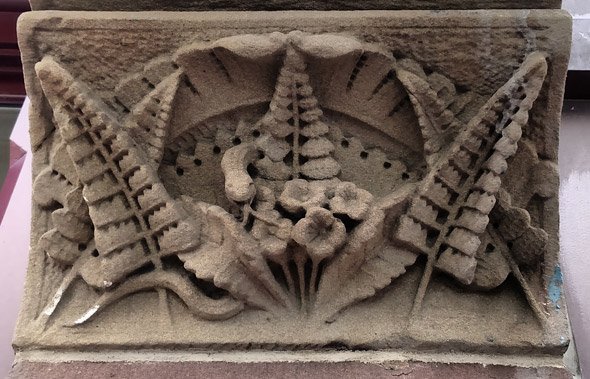Hey, there! Log in / Register
Pillar snake is watching you
By adamg on Wed, 04/29/2015 - 8:02am

Look up as you walk by the Hong Lok House on Essex Street in Chinatown and you might see this snake staring back at you from a pillar on the original facade of the building.
Neighborhoods:
Free tagging:
Ad:

Comments
Detail
I wish newer building would add levels of detail like this to their design rather than the usual straight lines and glass plates
you're not alone
There was an interesting article about it in Boston Magazine yesterday - sort of long, but worth a read.
Attention housing developers
There are people all over Boston who make incredible detail work in stone plaster stained glass as well as new materials and send it all over the world. It costs money though. And it takes visual imagination which really is not that important here.
If developers worked in elements like this to relate to the humanity which walked around and into their buildings it would be easier to get new buildings approved.
Instead we get insulted as nimbys because we don't want a crappy shoddy boring building that won't grow into the neighborhood.
That's why neighbors hate new building. Because too much of it is cheap.
The BRA has repeatedly
The BRA has repeatedly allowed old ornate buildings to be torn down or developers to cry poor rather than perform facadectomys with new buildings.
Hong Luk is a relatively poor organization and they saved this series of beautiful facades. Meanwhile Ron Druker down the street with approval of the BRA is permitted to destroy the Shreve Crump and Low building out of "budget concerns".
Cheapskate developers and their accomplices at the BRA are to blame for proliferation of bland buildings in the city. =(
Hel-lo, Little Guy!
It's amazing, how many years one can work/live in a neighborhood and miss such details.
(When I was a kid, someone told me not to look up, as that'd make me look like a tourist.)
A wise individual....
... would learn to take he same joy in his/her home city as vistors routinely find there.
;-}
(So -- by all means -- never stop looking up, and down and around), no matter what the "adults" tell you.
Wisdom comes with age.
I've got plenty of age, now, if not wisdom. Did learn that, while there is aesthetic value to be gathered in looking up, the monetary value is in looking down. (Particularly dimes at bus stops).
Speaking of wisdom / knowledge: is this maybe a stylized take on the Garden of Eden? You don't often see snakes of this fellow's size slithering around among the ferns and primroses.
I wonder what the building was originally?
It coud just be a visual pun on the name of one of the people involved in building this place.
That's always a possibility.
Ever notice the cows heads on some public buildings here? The Somerville PL Central Branch has them. Learned about "Buchrania" in Boston Civil Architecture from Mr. Gaffin, actually.
(Sometimes a Cow's Head a just a Cow's head; sometimes a Snakie is just a Snake...)
***
Getting the urge to wander around South of the Charles again; particularly to see the Chinatown Wonders and maybe the Cunard Building.
I like pillar snake
n/t
Yes, this and more!
I agree 100% that most modern architecture is BORING. Form can follow function but the face of a building is what looks at the public and what the public looks at. Modern facades are too often the emanations of corporate boards who want buildings dressed in the dreary boring boardness they see in mirrors.
There are the ocassional "look ma what I can do" structures of Gehry, the tight, tight, tight National Gallery East Wing corner by Pei (although his west wing at the MFA must have been phoned in). Ironically he was disappointed how the Kennedy Library turned out. I think it tends to be better than the average architectural monolith.
What I miss in modern architecture is the story telling that is done with details such as the snake. The narrative details, the visual puns, all the details that humanize buildings have been banished. It's sad. These details bridge the utter artificiality of buildings to the natural world of both human, animal and plant. The details relate the buildings to their peopled environment. Details dictate that buildings exist to serve people. Empty facades indicate that people exist to serve buildings. Building exteriors need to tell stories about where they stand, about the natural and human history of the locale and people who live there.